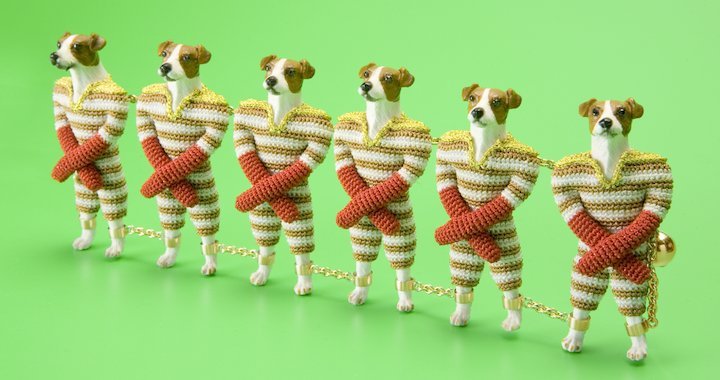
A Trip Into Felieke van der Leest’s World of Contemporary Jewelry
19/05/2014
The animal kingdom has become an oft used source of inspiration in today's contemporary jewelry design. Some artists simply produce creative interpretations of animal figures, while others imbue their creatures with multi-layered meanings and ideas. The world of miniature animals created by Dutch contemporary jewelry designer Felieke van der Leest (1968) is interwoven with references to historical and romanticized images of the American West and adept parodies of Olympic athletes, and in this world of hers she cleverly inserts word games, allusions and appeals to modern-day social issues.
The techniques and arsenal of materials used in contemporary jewelry making consist of more than just alloys of various precious and non-precious metals; in contemporary jewelry design, practically anything can be used. Van der Leest does not shy away from also using such domestic handcrafting techniques as knitting, crochet and beading. In fact, she admits that she needs her daily period of crocheting – which she does both in the morning and in the evenings after a day spent in her studio – almost as if it were a form of meditation. Precious metalworking is van der Leest's professionally acquired trade, which is why gold and silver make up a part of her work. However, the main role in her array of raw materials belongs to plastics; even more surprising is her use of ready-made plastic toy animals.
Occasionally Van der Leest creates pieces that are not meant to be actually worn on the body – they are simply design objects to be enjoyed just by looking at them. Usually, however, Van der Leest designs her works with the intent of being worn – although she does admit that not all of her pieces are comfortable enough to be worn daily, or for more than a few hours at a time. Some of her design works may contain a removable part that can be worn as an accessory, while still others may look like one single piece of jewelry, but can actually be taken apart into two separate pieces that can then be worn individually.
Although van der Leest currently lives in Norway, she originally comes from the northern Dutch town of Emmen; Emmen also happens to have a zoo, and as a girl, van der Leest often went to see the giraffes, elephants and other animals up close.
Van der Leest's teenage years coincided with the gothic-punk subculture that was coming into style, and of which she also became a fashion victim; to make her image more original, she decided to make her own earrings. At the same time, van der Leest really got into equestrian sports, and even harbored hopes of becoming a riding instructor. Even though nothing came of this plan, she didn't want to go to university, either. A lucky break came in the guise of her biology teacher, who reminded van der Leest of the jewelry she had made during her school years, and suggested she apply to a trade-school for precious metalworking.
From 1986 to 1991 van der Leest learned the trade of gold-smithing in the city of Schoonhoven, and in 1996 she graduated from the jewelry design program at the Gerrit Rietveld Academy in Amsterdam.
The use of miniature toy animals in her jewelry design also came about quite unexpectedly – it started in the autumn of 2002, when she got pain in her arms from having crocheted and knitted too intensely and for too many years. She decided that she had to change her method of working. She had already made some yearly Christmas gifts for her nephew and nieces from the miniature toy animals that she was fond of collecting. Deciding to develop this toy-animal idea, she started to seriously use them in her work. Van der Leest revisited the techniques that she had learned as a metalsmith, ones that she hadn’t used for years. Looking back, she is now thankful for the arm troubles that arose in 2002, since that is what forced her to begin working into another, even more interesting direction.
At the moment, Van der Leest positions herself as both a tradesperson and an artist: she is a painter, sculptor and a trained metalsmith. In labeling herself as an artist, van der Leest quickly adds that if no one was interested in her works, she would stop making them and turn to something else: “Oftentimes, artists talk about some sort of “inner drive” that makes them create and express themselves – no matter if it interests anybody else or not, nor if anyone wants to buy their work or not. This doesn't apply in my case.”
Van der Leest's works have been highly regarded in the international world of professional contemporary and conceptual jewelry art for several years now. They can be found in museums and private collections throughout the world, including at the Victoria and Albert Museum in London, in several museums in the Netherlands and Norway, as well as in the Montreal Decorative Arts Museum in Canada, and the Museum of Fine Arts, Houston, in the USA. Van der Leest has been taking active part in international group shows since 1996, and has been holding her own solo shows since 1997.
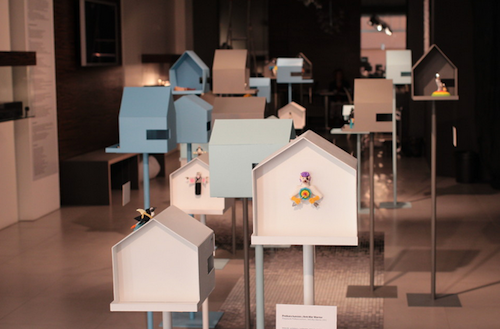
Photo: Putti.lv
For her solo show, “Life is a ZOO”/”Dzīve ir ZOO”, at the gallery “Putti” in Riga, and held in April of this year, van der Leest brought along a considerable selection of her work in jewelery design. The exhibition featured pieces from her series, “F.I.B.S. (Festival International des Bêtes Sportives)”, which were created in the period of 2008 to 2009, as well as from the series, “Once Upon a Time in My West”, which was inspired by the culture of the American Wild West – a theme that has captivated van der Leest since 2010.
The layout for the “Life is a ZOO” exhibition in Riga was designed by the Latvian scenographer, Sintija Jēkabsone. Photo credit: Putti.lv
The exhibition's layout at the “Putti” gallery was the brainchild of Latvian scenographer Sintija Jēkabsone, who transformed the space into a stylized village of birdhouses. Supported by a single pole, each little cubbyhole served as housing for one of the characters from van der Leest's collection. The artist admits that she always entrusts the layout of the exhibition to somebody else, but notes that she's never had anything this special before. The only other time that remains so vivid in her memory is her 2006 exhibition, “Jewellery Fables”, at the Dorman Museum in the English city of Middlesbrough – there, her works were integrated into the museum's displays on nature, geology and the social sciences.
As seen in the exhibition, the zoological gardens of van der Leest's imagination are not a frozen place of entrapment, but rather an improvised and real environment, in which socially active characters from the Wild West, Native Americans and Olympic champions all come together in one place. The following are eight pieces about which we wanted to learn more, and we asked the artist to explain them in more detail.
***
Van der Leest begins her description of the show with a special piece, namely – a red, crocheted sperm in the shape of a heart, which is pinned to her jacket's lapel. The artist is never without it. She created “Spermheart” in 1996, upon finishing her studies at the Gerrit Rietveld Academy.
“My works are mostly inspired by animal toys, specifically. And I have a lot of them at home! I bought them in toy stores, but now I buy them online – they have all the brands to choose from. Because I make small editions, I need more than one; in addition, I now live in the countryside and even though there is a toyshop in the nearby village, they only sell one brand. But I've scored my best finds in museum shops during my travels. I am now an “expert” in knowing all of the brands in the world, and it is much easier to buy them online nowadays. Every January the brands show their new animals for the year – that is a very exciting time for me, as you can imagine. Sometimes it happens backwards – I come up with the name of the piece first, and then I try to shape my design to fit it. That's not always easy; it's actually quite hard to find the appropriate character because sometimes, there's something in the toy animal's image and expression that just doesn't go with my concept.”
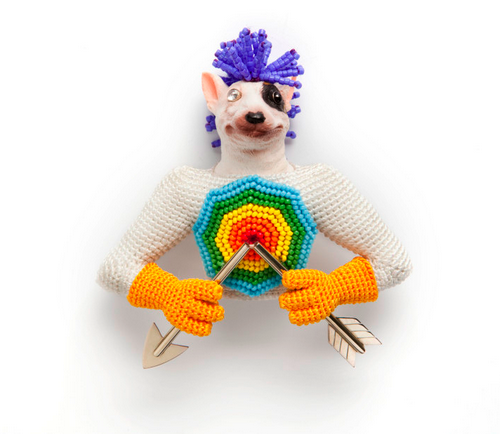
Anti-War Warrior. 2012
1. We stop in front of Anti-War Warrior (2012). It's a brooch composed of the bust of a dog that has a shield of colored plastic beads on its chest. The dog holds in its hands a broken silver arrow. Van der Leest also draws back the arrow in her cross-bow of storytelling: “An anti-warrior – that's a great contradiction. I like to make plays on contradictory things. A round shield can be seen in several of my works – it's the target at which arrows are aimed. Another frequent motif is the rainbow palette. In this work, I've combined the two by replacing the usual bi-colored shield with a rainbow-hued target.”
“When I was little, I had a button with the symbol of a broken rifle – that was a popular emblem at the time because that was when people were actively protesting against the war, against weapons... You see, the dog is holding the broken arrow up to his chest just as if it were a rifle. He is an anti-war soldier! Since this soldier is from my Once Upon a Time in My West series of works, this allusion to the gay-rights flag could be applied to the recent fervor over anti-homosexual propaganda during the Sochi Olympic Games.”
“And another thing... you'll see that the rainbow is lacking the color purple. I couldn't use it because then the shield would have been too big; so, I made the dog's hair purple. The rainbow hasn't lost its shade, and the dog has the same hairstyle as the Native American in one of the books that I remember from childhood – James Fenimore Cooper's historical novel, 'The Last of the Mohicans', which takes place during the French and Indian War. So, every detail in this work has its own place. I was so happy when it turned out! It is a wonderful moment when I finish a work in which I've successfully combined something that seemed thematically incompatible!”
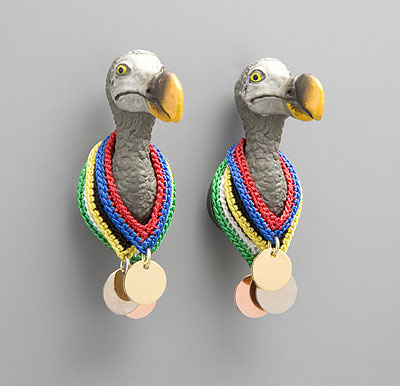
The Outsiders. 2008
2. “There are some more contradictions in the F.I.B.S. sports-themed series, for instance, the ballerina-hippopotamus (Prima Ballerina Hippo-Lolita, 2008), and the piece titled The Outsiders. The 'outsiders' are two dodo birds from the extinct species of flightless birds. The dodo birds used to live on the Island of Mauritius in the Indian Ocean, but then the Dutch arrived and left some pigs on the island – so that when they headed back to the Netherlands, they could pass the island and pick up the pigs for food. But these pigs had eaten all of the dodo eggs. These birds couldn't fly, they only walked, so they were true outsiders. But in my piece, I've awarded them Olympic medals – all three of them – gold, silver and bronze!”
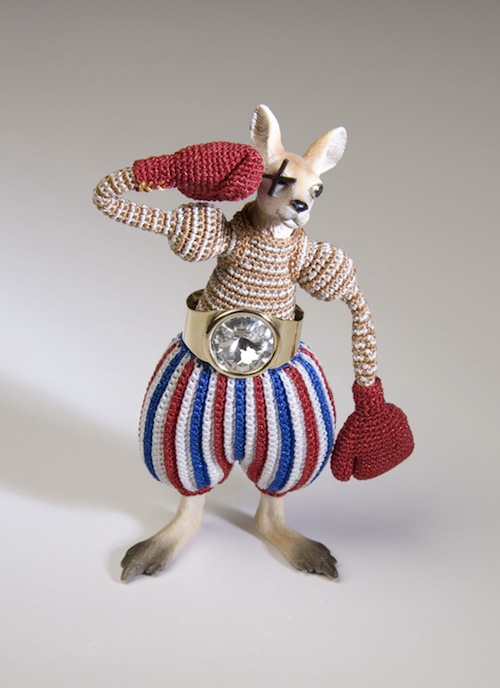
Billy Bang. 2009
3. “This is Billy Bang, a kangaroo dressed in the colors of the American flag. Rodeo clowns also wear red, white and blue – that's another allusion. He's wearing boxing gloves. One of his eyes is a black cross, like the cartoonists draw when it has to look like the eye has been hit. The other eye is a blue sapphire. In English, the term for a bruised eye is 'black eye' [in Dutch, a bruised eye is called a 'blue eye' – ed.], and that's why he has an injured eye that is colored black. I use such plays on words in my work.”
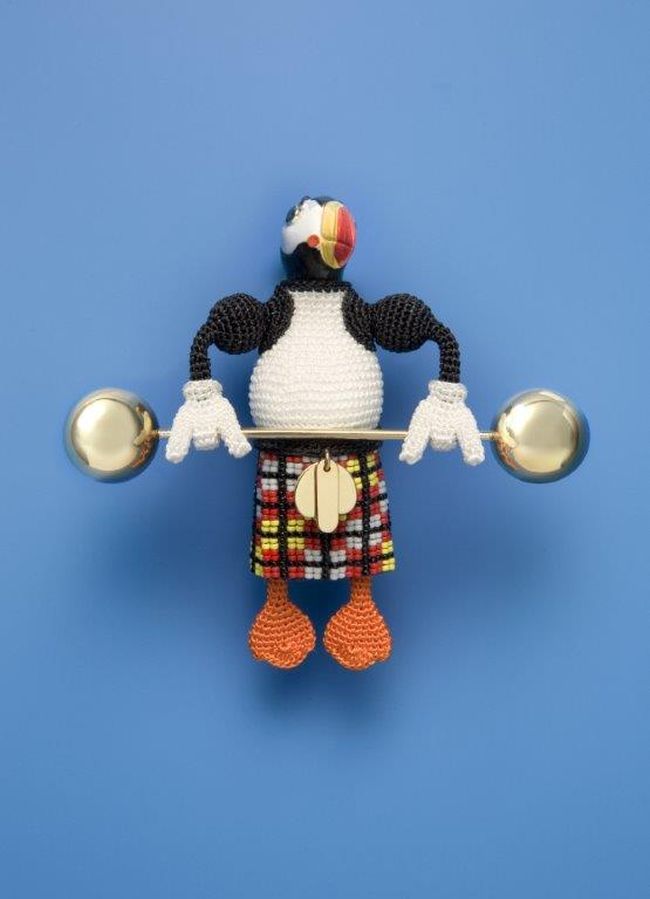
McPuffin. 2009
4. “Another play on words can be seen in the work McPufff (2009). When a person is exhausted and out of breath, he pants and makes a sound like 'pffff...'. In Dutch, panting is designated with the word 'puff'. That's how I came up with the name for this piece.”
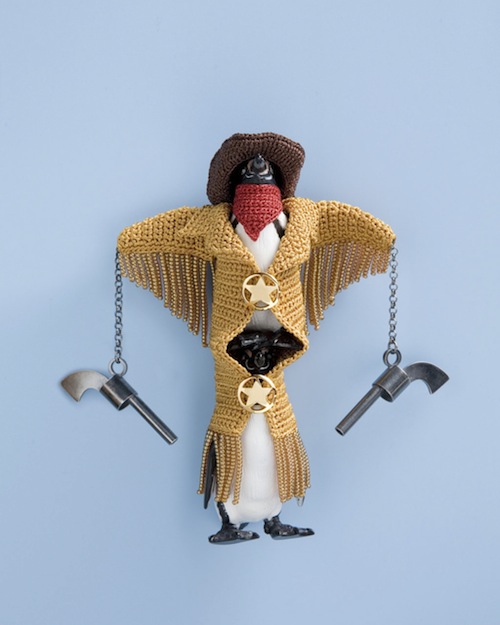
Billy the Kids. 2011
5. “There's a special story behind these two little penguins standing on top of each other, so that they look a big grown-up; it's called Billy the Kids, from the series Once Upon a Time in My West. Billy the Kid was a notorious outlaw and beloved folk hero/cowboy/gunman in the Wild West. He could shoot very good with a gun and killed many people – although in reality, probably less than in the stories. Mostly boys like to play 'cowboys and Indians', especially because they like to shoot with toy guns. In this piece, the two little penguins make themselves look like they are one big person by standing on top of each other. The pistols hang out of their sleeves, like children’s gloves that are attached so that they don't get lost. The buttons on the jacket look like a sheriff's star pin. The sheriff always goes after the criminal, so it's a bit controversial to have the criminal also wearing the sign of a sheriff.”
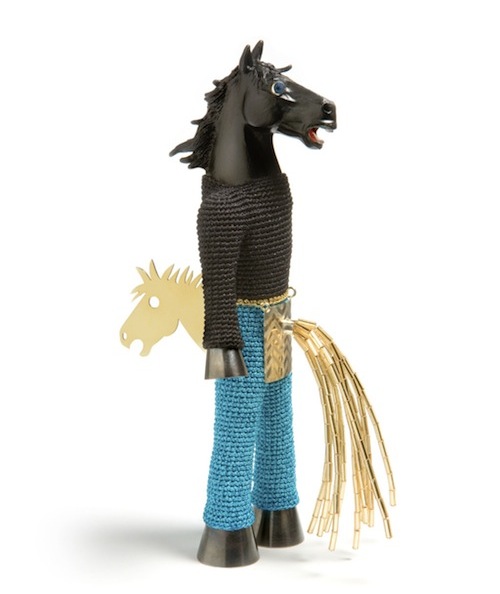
Crazy Horse. 2010
6. “The idea for Crazy Horse (2010) began with the horse itself – when I saw it with its open mouth, it made me think that it was screaming. It's crazy! Then I came up with the idea of a stick horse, the kind that children like to run around with. But I couldn't put another horse in front of the main horse – then there would be two heads and it would be a bit dull. I decided to turn the stick horse backwards, so that its golden tail, which is now in the front, makes it look as if the main horse is peeing. The real man who was named Crazy Horse is an iconic figure in Native American culture. There's even a commemorative postage stamp of him included in the US postal stamp series of notable Americans. My 'crazy horse' doesn't have anything in common with the story of the Native American warrior – his story is quite sad, of course, since he was killed by an American military guard.”
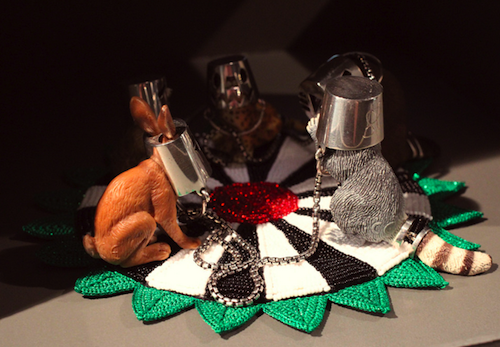
Incognitos Anonymous. 2011. Photo: Putti.lv
7. “Incognitos Anonymous is an object with a necklace. It is made up of five animals with special Native American tribal masks which, for some reason, are slightly reminiscent of jack-o-lanterns. They're having an anonymous meeting in which they're sort of sitting around a bonfire. The bonfire is symbolized by a black and white circle, with also some red and green that, again, recalls the target shield and, at the same time, a roulette wheel. This is the back-story for it – the impoverished Native American reservations in the USA are allowed to have gambling establishments on them, which is strictly forbidden in other parts of the States, and so the reservations make quite a bit of money from this business. I played a bit with the title of 'AA', (the support group, 'Alcoholics Anonymous'). The word incognitos means the same thing as anonymous, so it doubles up. And see, the animals here have come together wearing masks – they're incognito, and much like recovering alcoholics, they are anonymous in their struggle against gambling addiction.”
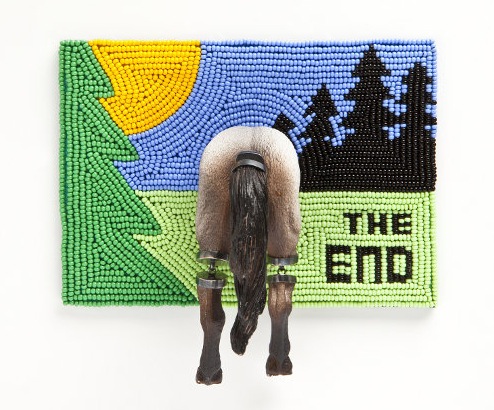
The End 4. 2013
8. “And here we have Lucky Luke! – from the Belgian comic strip, Lucky Luke, who draws his gun faster than his shadow and has a loyal horse, Jolly Joker. The stories always end with the iconic scene in which Lucky Luke, on horseback, rides off into the sunset. This type of a frame was stuck in my memory. I have several variations of this scene and I've given them the title of The End. What's funny is that after I had finished the first piece, only then did I notice the association between 'The End' and the end part of the horse!”
****
Van der Leest is currently working on “The Last Frontier”, a larger object for her Wild West series. It's going to be a Western-style covered wagon that's heading towards the symbolic border frontier. For her next series, van der Leest plans on heading to the era of the dinosaurs, placing these prehistoric creatures at the center of her works.
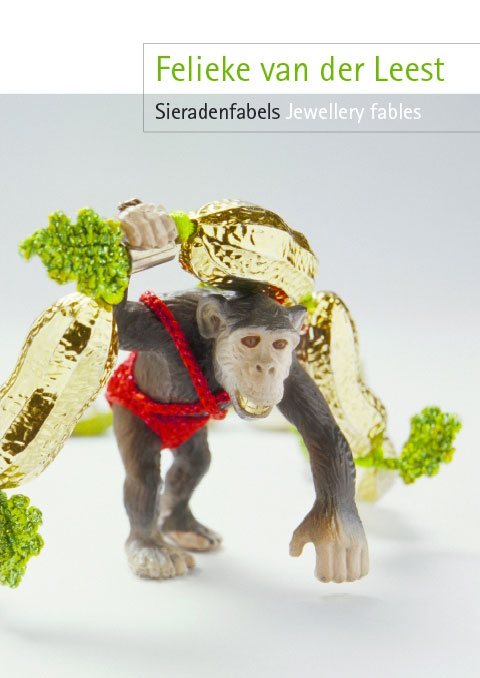
Felieke van der Leest's 2006 book, “Sieradenfabels” / “Jewellery Fables”. A new book is slated for release at the end of this year
A second book on the artworks of Felieke van der Leest is slated to come out in December of 2014. The accompanying texts have been authored by the Norwegian art critic Jorunn Veiteberg. There already is a book featuring the works of van der Leest – “Sieradenfabels” / “Jewellery fables”, which was published in 2006 by the Middlesbrough Institute of Modern Art (mima); it is not only a compendium of information on van der Leest's works, but also an overview of the use of animal motifs in jewelry throughout history.